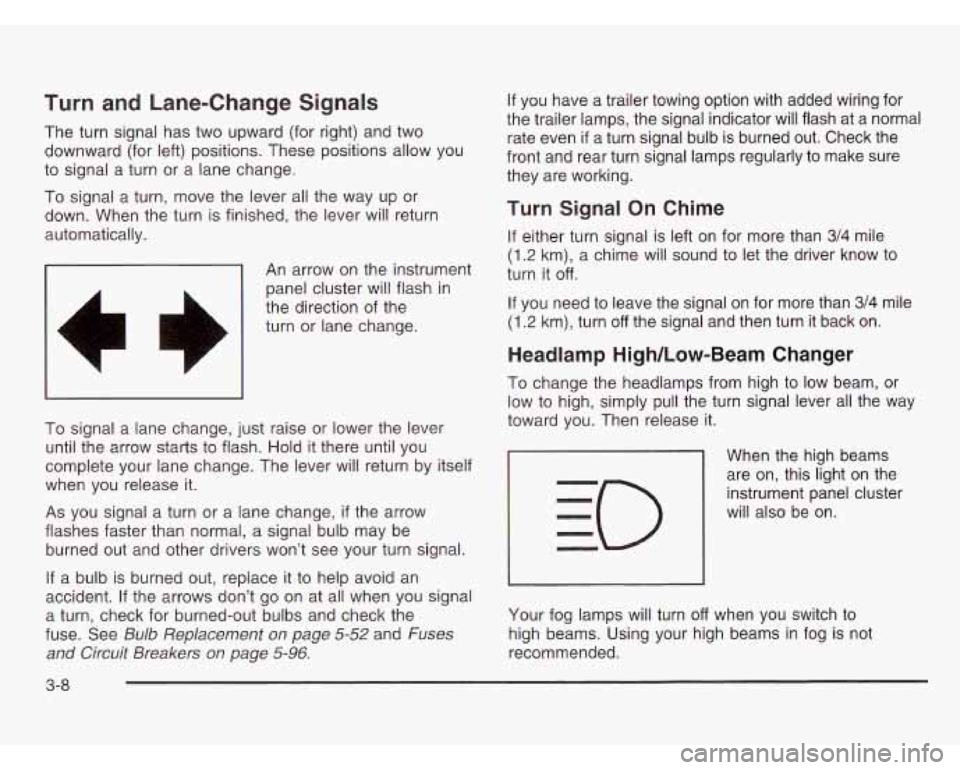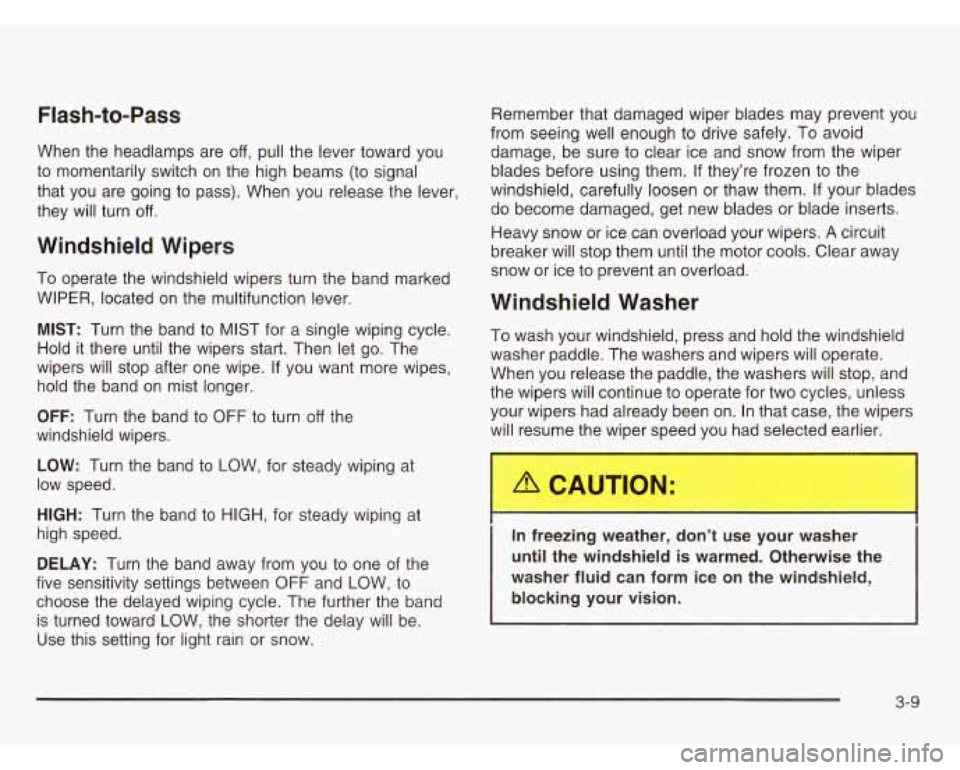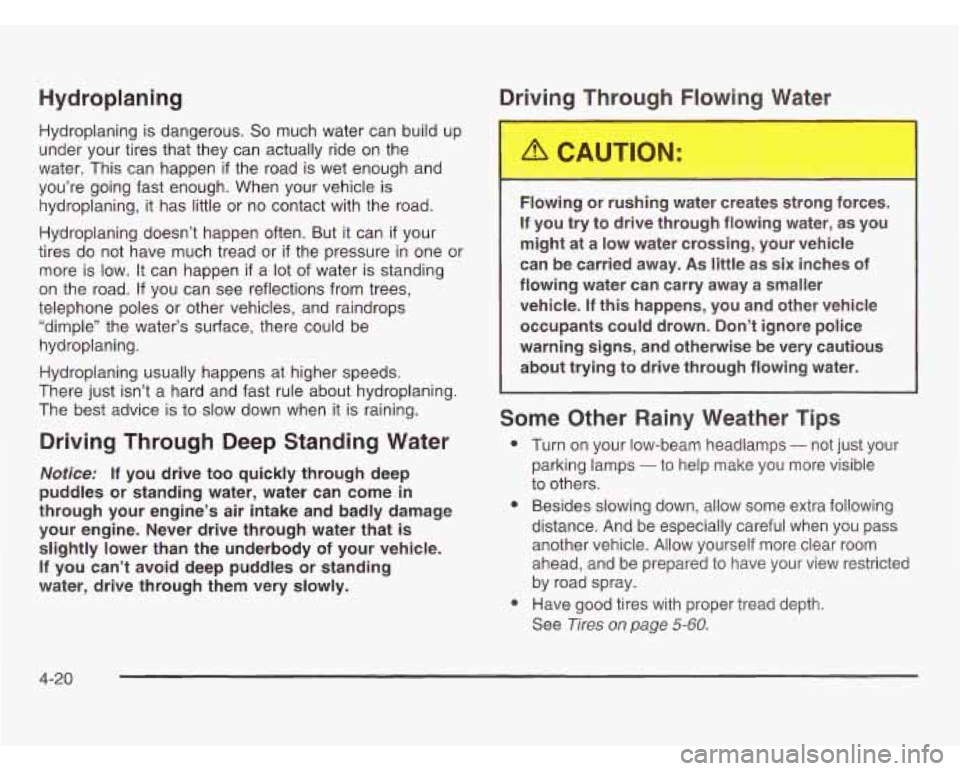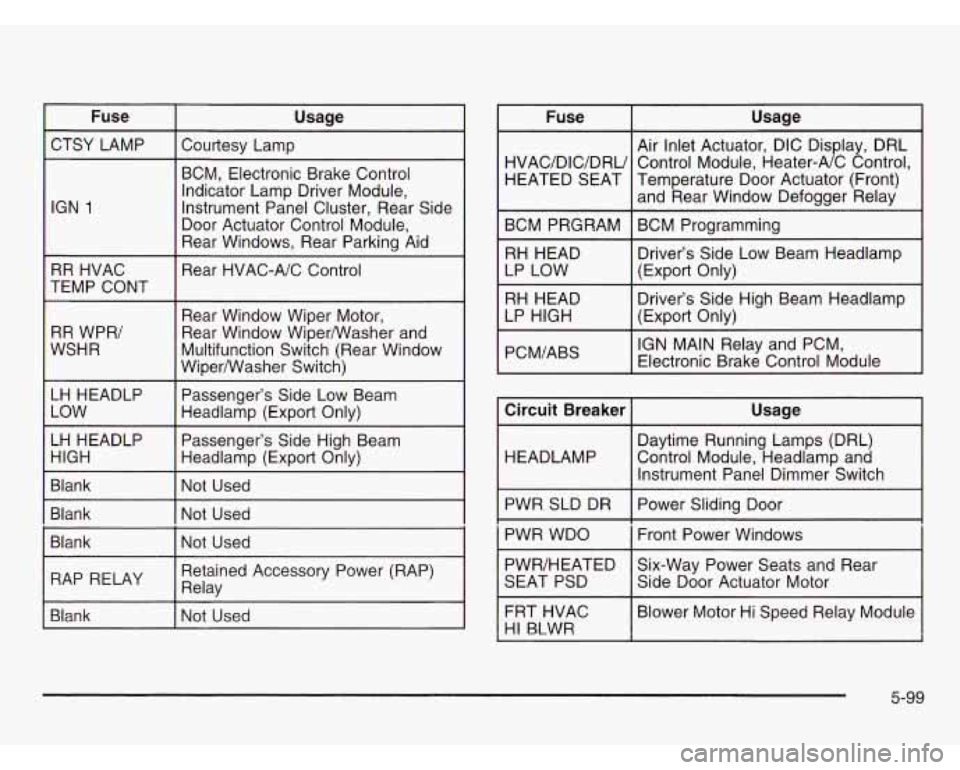low beam OLDSMOBILE SILHOUETTE 2003 Owners Manual
[x] Cancel search | Manufacturer: OLDSMOBILE, Model Year: 2003, Model line: SILHOUETTE, Model: OLDSMOBILE SILHOUETTE 2003Pages: 466, PDF Size: 21.55 MB
Page 165 of 466

Turn and Lane-Change Signals
The turn signal has two upward (for right) and two
downward (for left) positions. These positions allow you
to signal a turn or a lane change.
To signal a turn, move the lever all the way up or
down. When the turn is finished, the lever will return
automatically.
-1 An arrow on the instrument
panel cluster will flash in
the direction of the
turn or lane change.
To signal a lane change, just raise or lower the lever
until the arrow starts to flash. Hold it there until you
complete your lane change. The lever will return by itself
when you release it.
As you signal a turn or a lane change,
if the arrow
flashes faster than normal, a signal bulb may be
burned out and other drivers won’t see your turn signal.
If a bulb is burned out, replace it to help avoid an
accident. If the arrows don’t go on at all when you signal
a turn, check for burned-out bulbs and check the
fuse. See
Bulb Replacement on page 5-52 and Fuses
and Circuit Breakers on page
5-96.
If you have a trailer towing option with added wiring for
the trailer lamps, the signal indicator will flash at a normal
rate even
if a turn signal bulb is burned out. Check the
front and rear turn signal lamps regularly to make sure
they are working.
Turn Signal On Chime
If either turn signal is left on for more than 3/4 mile
(1.2 km), a chime will sound to let the driver know to
turn
it off.
If you need to leave the signal on for more than 3/4 mile
(1.2 km), turn off the signal and then turn it back on.
Headlamp High/Low-Beam Changer
To change the headlamps from high to low beam, or
low to high, simply pull the turn signal lever all the way
toward you. Then release it.
When the high beams
are on, this light on the
instrument panel cluster
will also be on.
Your fog lamps will turn
off when you switch to
high beams. Using your high beams in fog is not
recommended.
3-8
Page 166 of 466

Flash-to-Pass
When the headlamps are off, pull the lever toward you
to momentarily switch on the high beams (to signal
that you are going to pass). When you release the lever,
they will turn
off.
Windshield Wipers
To operate the windshield wipers turn the band marked
WIPER, located on the multifunction lever.
MIST: Turn the band to MIST for a single wiping cycle.
Hold it there until the wipers start. Then let
go. The
wipers will stop after one wipe.
If you want more wipes,
hold the band on mist longer.
OFF: Turn the band to
OFF to turn off the
windshield wipers.
LOW: Turn the band to LOW, for steady wiping at
low speed.
HIGH: Turn the band to HIGH, for steady wiping at
high speed.
DELAY: Turn the band away from you to one of the
five sensitivity settings between
OFF and LOW, to
choose the delayed wiping cycle. The further the band
is turned toward LOW, the shorter the delay will be.
Use this setting tor light rain or snow. Remember that damaged
wiper blades may prevent you
from seeing well enough to drive safely. To avoid
damage, be sure to clear ice and snow from the wiper
blades before using them.
If they’re frozen to the
windshield, carefully loosen or thaw them. If your blades
do become damaged, get new blades or blade inserts.
Heavy snow or ice can overload your wipers.
A circuit
breaker will stop them until the motor cools. Clear away
snow or ice to prevent an overload.
Windshield Washer
To wash your windshield, press and hold the windshield
washer paddle. The washers and wipers will operate.
When you release the paddle, the washers will stop, and
the wipers will continue
to operate for two cycles, unless
your wipers had already been on. In that case, the wipers
will resume the wi--
- r speed you had selected earlier.
I I
In freezing weather, don’t use your washer
until the windshield is warmed. Otherwise the
washer fluid can form ice on the windshield,
blocking your vision.
3-9
Page 281 of 466

You can be temporarily blinded by approaching
headlamps. It can take a second or two, or even
several seconds, for your eyes to readjust to the dark.
When you are faced with severe glare (as from a
driver who doesn’t lower the high beams, or a vehicle
with misaimed headlamps), slow down a little. Avoid
staring directly into the approaching headlamps.
Keep your windshield and all the glass on your vehicle
clean
- inside and out. Glare at night is made much
worse by dirt on the glass. Even the inside of the glass
can build up a film caused by dust. Dirty glass makes
lights dazzle and flash more than clean glass would,
making the pupils of your eyes contract repeatedly.
Remember that your headlamps light up far less of a
roadway when you are in a turn or curve. Keep your
eyes moving; that way, it’s easier to pick out dimly
lighted objects. Just as your headlamps should be
checked regularly for proper aim,
so should your eyes
be examined regularly. Some drivers suffer from
night blindness
- the inability to see in dim light - and
aren’t even aware of it.
Driving in Rain and on Wet Roads
Rain and wet roads can mean driving trouble. On a wet
road, you can’t stop, accelerate or turn as well because
your tire-to-road traction isn’t as good as on dry roads.
And,
if your tires don’t have much tread left, you’ll get
even less traction. It’s always wise to go slower and
be cautious
if rain starts to fall while you are driving.
The surface may get wet suddenly when your reflexes
are tuned for driving on dry pavement.
4-1 8
Page 283 of 466

Hydroplaning .-- Thr -W
Hydroplaning is dangerous. So much water can build up
under your tires that they can actually ride on the
water. This can happen
if the road is wet enough and
you’re going fast enough. When your vehicle is
hydroplaning, it has little or no contact with the road.
Hydroplaning doesn’t happen often. But it can
if your
tires do not have much tread or
if the pressure in one or
more is low. It can happen
if a lot of water is standing
on the road.
If you can see reflections from trees,
telephone poles or other vehicles, and raindrops
“dimple” the water’s surface, there could be
hydroplaning.
Hydroplaning usually happens at higher speeds.
There just isn’t a hard and fast rule about hydroplaning.
The best advice is to slow down when it is raining.
Driving Through Deep Standing Water
Nofice: If you drive too quickly through deep
puddles or standing water, water can come in
through your engine’s air intake and badly damage your engine. Never drive through water that
is
slightly lower than the underbody of your vehicle.
If you can’t avoid deep puddles or standing
water, drive through them very slowly.
~ Flowing or rushing water creates strong forces.
~ If you try to drive through flowing water, as you
might at
a low water crossing, your vehicle
can be carried away.
As little as six inches of
flowing water can carry away a smaller
vehicle. If this happens, you and other vehicle
occupants could drown. Don’t ignore police
warning signs, and otherwise be very cautious
about trying to drive through flowing water.
9
e
Some Other Rainy Weather Tips
Turn on your low-beam headlamps - not just your
parking lamps -to help make you more visible
to others.
Besides slowing down, allow some extra following
distance. And be especially careful when you pass
another vehicle. Allow yourself more clear room
ahead, and be prepared to have your view restricted
by road spray.
Have good tires with proper tread depth.
See
Tires on page 5-60.
9
4-20
Page 406 of 466

Fuse Usage
CTSY LAMP Courtesy Lamp
IGN
1
~~ ~ ~~____
BCM, Electronic Brake Control
Indicator Lamp Driver Module,
Instrument Panel Cluster, Rear Side
Door Actuator Control Module,
Rear Windows, Rear Parking Aid
~~
RR HVAC
TEMP CONT
RR WPR/
WSHR Rear
HVAC-A/C Control
Rear Window Wiper Motor,
Rear Window WiperNVasher and
Multifunction Switch (Rear Window
Wiper/Washer Switch)
LH HEADLP Passenger’s Side Low Beam
I Headlamp (Export Only)
Passenger’s Side High Beam
Headlamp (Export Only)
I Blank I Not Used
I Blank I Not Used
Blank Not Used
I
I RAP RELAY I Relay Retained Accessory Power (RAP) I
Blank l-Nat Used Fuse
Usage
Air Inlet Actuator, DIC Display, DRL
HVAC/DIC/DRU Temperature Door Actuator (Front) HEATED SEAT
Control
Module, Heater-A/C Control,
and Rear Window Defogger Relay
BCM PRGRAM BCM Programming
RH HEAD Driver’s Side Low Beam Headlamp
LP LOW (Export Only)
RH HEAD
(Export Only)
I LP HIGH Driver’s
Side High Beam Headlamp
PCM/ABS
I IGN MAIN Relay and PCM,
Electronic Brake Control Module
Circuit Breaker
I Usage
I 1
Daytime Running Lamps (DRL)
HEADLAMP Control Module, Headlamp and
Instrument Panel Dimmer Switch
PWR SLD DR
I Power Sliding Door
PWR WDO
i Front Power Windows i
PWR/HEATED Six-Way Power Seats and Rear
SEAT PSD
I Side Door Actuator Motor
FRT HVAC
I Blower Motor Hi Speed Relay Module
HI B4WR I
5-99